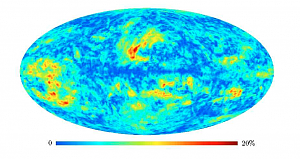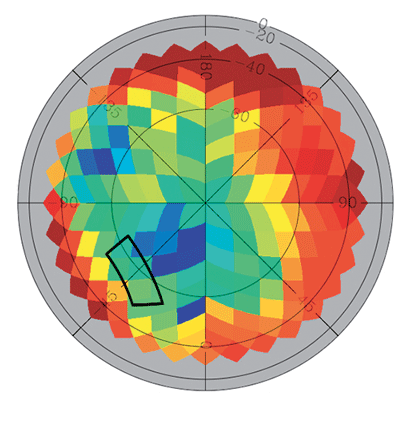BICEP: Spacetime Ripples or Galaxy Dust?

“Space Ripples Reveal Big Bang’s Smoking Gun,” read the New York Times headline last March 17. In a seemingly momentous news conference at the Harvard–Smithsonian Center for Astrophysics, researchers using a BICEP (Background Imaging of Cosmic Extragalactic Polarization) telescope at the South Pole announced that they had detected the first direct evidence for cosmic inflation, a theory about the very beginnings of the universe first proposed in 1979.
The BICEP announcement claimed that the first images of gravitational waves, or ripples in spacetime, had been detected, a tantalizing and long hoped-for connection between quantum mechanics and general relativity. The landmark claim ignited the field and led to talk of a new era of cosmology.
At the Institute for Advanced Study, Raphael Flauger, Member (2013–14) in the School of Natural Sciences, began looking closely at the data. The year prior, Flauger had analyzed the first round of cosmic microwave background data released by the Planck satellite, a mission of the European Space Agency, which the BICEP team had used in its findings.
“Initially, the announcement was very exciting,” says Flauger. “Like everyone, I thought it would be great if they had detected quantum fluctuations in the space-time metric that were generated when the universe was 10-30 seconds old. That’s a big, big thing to look at. It was a unique opportunity.”
But as Flauger delved deeper into the evidence, he grew to doubt whether the BICEP team had detected evidence of primordial gravitational waves. The issue hinged on the nature of the detected B-modes, a polarization pattern identified as a means for detecting such waves by Matias Zaldarriaga, Professor in the School of Natural Sciences, and Uros Seljak in 1997. Foreground contamination from dust in the Milky Way can lead to a similar B-mode signature. Flauger began to believe that the BICEP team had underestimated the level of dust in a Planck slide that the team had lifted from a 2013 presentation and used in their study. The slide was based on unpublished polarization data; Planck plans to release the actual polarization data later this year, which should clarify the cause of the B-modes.
Flauger presented his own analysis at Princeton University in May, and his doubts and those of others about BICEP’s claims were widely reported in the media. “BICEP definitely detected B-modes, but it is unclear if they are caused by primordial gravitational waves or if they are caused by dust in our galaxy,” says Flauger, who recently coauthored the paper “Toward an Understanding of Foreground Emission in the BICEP2 Region” with astrophysicists James Colin Hill and David Spergel, current Visitor (2014) in the School of Natural Sciences. On September 19, Planck researchers published a paper confirming that the amount of galaxy dust had been underestimated by the BICEP team.
According to the standard cosmology model, in the current phase in the history of the Big Bang, the universe began about fourteen billion years ago. Initially the universe was hot and dense with interacting particles. It has been conjectured that prior to this phase, the universe underwent a brief period of accelerated expansion known as inflation when quantum fluctuations, stretched to cosmologically large scales, became the seeds of the universe’s stars and galaxies.
A map released by Planck in 2013—a composite made from nine maps of the sky in nine different frequencies by the Planck satellite—captures the early light from the cosmic microwave background radiation that is remnant from the Big Bang. The cosmic microwave background was first detected in 1964, and since then space, ground, and balloon-based experiments have mapped temperature variations of this light left over from the very early universe, allowing cosmologists to see if theoretical models can reproduce the formation of objects that can be seen through cosmic history.
In the 1980s, cosmologists developed inflation models of the very early universe that incorporated our current understanding of the laws of physics—the laws of general relativity to understand how gravity works, and quantum mechanics to understand how matter behaves.
To explain the universe’s longevity and homogeneity, theorists introduced a period of inflation before the Big Bang. Without it, a universe, behaving according to the laws of general relativity, would collapse into a black hole or become completely empty within a period of a few fractions of a second. Inflation had a surprise bonus: due to the uncertainty principles of quantum mechanics, inflation had to last longer in different regions. These tiny differences could then act as the seeds for structure.

A theoretical physicist, Flauger first became interested in cosmic microwave background data as a doctoral student of Steven Weinberg’s at the University of Texas at Austin. In 2007, Flauger and Weinberg wrote a paper related to tensor fluctuations in the microwave background, which predict B-modes that show up as gravitational waves in spacetime. Since then, Flauger and others have worked to develop models in the context of string theory that incorporate observably large B-modes. Prior to these models, it was speculated that the discovery of B-modes could disprove string theory.
“The nice thing about B-modes is that if you measure them, they tell you something about the energy scale during the earliest moments in the universe,” says Flauger, now Assistant Professor at Carnegie Mellon University. “If you see such a B-mode signal, you can show that it means that the energy scale is quite high, about 1016 GeV, which is typically what people associate with the grand unified theory scale, and it is not so far from the string scale. With this data set, we have hopes of learning more about string theory.”
Like CERN’s Large Hadron Collider experiment, which detected the Higgs particle nearly fifty years after it had been predicted in theory, theoretical models are allowing the Planck team to determine the composition of the universe, map the seeds for the formation of structure, and confirm our broad understanding of the beginnings and evolution of the universe. Flauger, for one, has been looking at other features in the microwave background predicted by B-mode string theory models. Unrelated to B-modes, Flauger and his collaborators Eva Silverstein and Liam McAllister have been looking for axion scalar field signatures in Planck’s temperature data, which support a subset of stringy models. Planck is expected to use this theoretical work in their analysis of the polarization data later this year.
According to inflation theory, as the universe expands exponentially fast, its geometry becomes flat—this geometry was confirmed experimentally around 2000. Theorists then had to use the laws of physics to solve the problem of how to make the inflation stop so that the universe cools and structure starts to form. “The axion scalar field works like a clock,” says Flauger. “This clock, it is slowly rolling, but then it has small ripples, marking time. We are looking for features imprinted in the primordial power spectrum from these small periodic features. To me, identifying these would be interesting because people hadn’t looked for them before the stringy models were proposed. It would not necessarily mean that string theory is true because they could have been proposed earlier, but they weren’t.”
Beyond questioning the actual results of BICEP, there are a number of outstanding questions about inflation. Among them, asks Zaldarriaga, “Is it true that the only way to produce gravitational waves is through inflation?” In the meantime, astrophysicists and theorists continue to debate the nature of BICEP’s findings, awaiting the release of the remaining Planck data.
“If the B-modes are as strong as BICEP says, Planck should also be able to see them,” says Flauger. “That would be really exciting because then we would just know for sure. But we will have to wait and see. My suspicion is that there may still be primordial B-modes in the signal, but that there is also significant dust contribution and that would make it very hard for Planck to see them.
“Sometimes it gets phrased that BICEP is just wrong, but I think these maps, no matter what, will be important. They will be used in combination with other datasets to understand if there are primordial B-modes there or not. They are very, very valuable.”
Recommended Viewing: “The Dawn of B-Mode Cosmology” by Professor Matias Zaldarriaga from Strings 2014: http://ow.ly/BC5hJ/. To read the Planck Collaboration’s paper, see http://arxiv.org/pdf/1409.5738.pdf